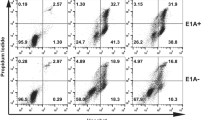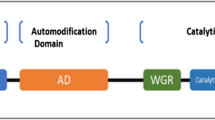Abstract
Poly(ADP-ribose) polymerase (PARP), which is activated by DNA strand breaks, is involved in DNA repair and replication but, during apoptosis, undergoes early caspase-mediated cleavage. Activation of programmed cell death in response to DNA damage may rely on functional p53 protein. Tumor cells are commonly deficient in this oncogene product resulting in resistance to many cytostatic drugs. Here we report that nicotinamide-induced inhibition of poly(ADP-ribosyl)ation and cytokine-induced nitric oxide production both result in a transient increase in p53 levels in pancreatic tumor RINm5F cells. These treatments also induce disruption of the mitochondrial membrane potential (ΔΨm), as revealed using the mitochondrial probe JC-1, followed by PARP cleavage and apoptosis all of which are inhibited by the anti-apoptotic protein Bcl-2. Moreover, PARP-inhibition by nicotinamide or 3-aminobenzamide induces apoptosis and/or cell cycle arrest at the G2 checkpoint in all of four tested tumor cell lines of both mesenchymal and epithelial origin including mouse NIH-3T3 cells and p53 deficient human HeLa and Jurkat cells. Bcl-2 counteracts cytokine-, but not nicotinamide-induced G2 arrest. These findings indicate that both chemical and caspase-mediated inhibition of PARP activity, possibly by interfering with DNA replication and repair, may promote a p53-independent G2 arrest and apoptosis.
Similar content being viewed by others
References
Rich T, Allen RL, Wyllie AH: Defying death after DNA damage. Nature 407: 777-783, 2000
Vousden KH: p53: Death star. Cell 103: 691-694, 2000
King KL, Cidlowski JA: Cell cycle regulation and apoptosis. Annu Rev Physiol 60: 601-617, 1998
Wahl AF, Donaldson KL, Fairchild C, Lee FY, Foster SA, Demers GW, Galloway DA: Loss of normal p53 function confers sensitization to Taxol by increasing G2/M arrest and apoptosis. Nat Med 2: 72-79, 1996
de Murcia G, Schreiber V, Molinete M, Saulier B, Poch O, Masson M, Niedergang C, Menissier de Murcia J: Structure and function of poly(ADP-ribose) polymerase. Mol Cell Biochem 138: 15-24, 1994
Simbulan-Rosenthal CM, Rosenthal DS, Hilz H, Hickey R, Malkas L, Applegren N, Wu Y, Bers G, Smulson ME: The expression of poly(ADP-ribose) polymerase during differentiation-linked DNA replication reveals that it is a component of the multiprotein DNA replication complex. Biochemistry 35: 11622-11633, 1996
Satoh MS, Lindahl T: Role of poly(ADP-ribose) formation in DNA repair. Nature 356: 356-358, 1992
de Murcia JM, Niedergang C, Trucco C, Ricoul M, Dutrillaux B, Mark M, Oliver FJ, Masson M, Dierich A, LeMeur M, Walztinger C, Chambon P, de Murcia G: Requirement of poly(ADP-ribose) polymerase in recovery from DNA damage in mice and in cells. Proc Natl Acad Sci USA 94: 7303-7307, 1997
Le Rhun Y, Kirkland JB, Shah GM: Cellular responses to DNA damage in the absence of Poly(ADP-ribose) polymerase. Biochem Biophys Res Commun 245: 1-10, 1998
d'Adda di Fagagna F, Hande MP, Tong WM, Lansdorp PM, Wang ZQ, Jackson SP: Functions of poly(ADP-ribose) polymerase in controlling telomere length and chromosomal stability. Nat Genet 23: 76-80, 1999
Nicholson DW, Ali A, Thornberry NA, Vaillancourt JP, Ding CK, Gallant M, Gareau Y, Griffin PR, Labelle M, Lazebnik YA et al.: Identification and inhibition of the ICE/CED-3 protease necessary for mammalian apoptosis. Nature 376: 37-43, 1995
Scaffidi C, Fulda S, Srinivasan A, Friesen C, Li F, Tomaselli KJ, Debatin KM, Krammer PH, Peter ME: Two CD95 (APO-1/Fas) signaling pathways. EMBO J 17: 1675-1687, 1998
Kroemer G, Dallaporta B, Resche-Rigon M: The mitochondrial death/life regulator in apoptosis and necrosis. Annu Rev Physiol 60: 619-642, 1998
Knip M, Douek IF, Moore WP, Gillmor HA, McLean AE, Bingley PJ, Gale EA: Safety of high-dose nicotinamide: a review. Diabetologia 43: 1337-1345, 2000
Mabley JG, Suarez-Pinzon WL, Hasko G, Salzman AL, Rabinovitch A, Kun E, Szabo C: Inhibition of poly(ADP-ribose)synthetase by gene disruption or inhibition with 5-iodo-6-amino-1,2-benzopyrone protects mice from multiple-low-dose-streptozotocin-induced diabetes. Br J Pharmacol 133: 909-919, 2001
Saldeen J, Welsh N: Nicotinamide-induced apoptosis in insulin producing cells is associated with cleavage of poly(ADP-ribose) polymerase. Mol Cell Endocrinol 139: 99-107, 1998
Saldeen J, Curiel DT, Eizirik DL, Andersson A, Strandell E, Buschard K, Welsh N: Efficient gene transfer to dispersed human pancreatic islet cells in vitro using adenovirus-polylysine/DNA complexes or polycationic liposomes. Diabetes 45: 1197-1203, 1996
Karasuyama H, Melchers F: Establishment of mouse cell lines which constitutively secrete large quantities of interleukin 2, 3, 4 or 5, using modified cDNA expression vectors. Eur J Immunol 18: 97-104, 1988
Deng G, Podack ER: Suppression of apoptosis in a cytotoxic T-cell line by interleukin 2-mediated gene transcription and deregulated expression of the protooncogene bcl-2. Proc Natl Acad Sci USA 90: 2189-2193, 1993
Saldeen J: Cytokines induce both necrosis and apoptosis via a common Bcl-2-inhibitable pathway in rat insulin-producing cells. Endocrinology 141: 2003-2010, 2000
Bradford MM: A rapid and sensitive method for the quantitation of microgram quantities of protein utilizing the principle of protein-dye binding. Anal Biochem 72: 248-254, 1976
Vindelov LL, Christensen IJ, Nissen NI: A detergent-trypsin method for the preparation of nuclei for flow cytometric DNA analysis. Cytometry 3: 323-327, 1983
Carlsson C, Borg LA, Welsh N: Sodium palmitate induces partial mitochondrial uncoupling and reactive oxygen species in rat pancreatic islets in vitro. Endocrinology 140: 3422-3428, 1999
Salvioli S, Ardizzoni A, Franceschi C, Cossarizza A: JC-1, but not DiOC6(3) or rhodamine 123, is a reliable fluorescent probe to assess delta psi changes in intact cells: Implications for studies on mitochondrial functionality during apoptosis. FEBS Lett 411: 77-82, 1997
Laird PW, Zijderveld A, Linders K, Rudnicki MA, Jaenisch R, Berns A: Simplified mammalian DNA isolation procedure. Nucleic Acids Res 19: 4293, 1991
Adimoolam S, Lin CX, Ford JM: The p53-regulated cyclin-dependent kinase inhibitor, p21 (cip1, waf1, sdi1), is not required for global genomic and transcription-coupled nucleotide excision repair of UV-induced DNA photoproducts. J Biol Chem 276: 25813-25822, 2001
Mauricio D, Mandrup-Poulsen T: Apoptosis and the pathogenesis of IDDM: A question of life and death. Diabetes 47: 1537-1543, 1998
Packer MA, Murphy MP: Peroxynitrite causes calcium efflux from mitochondria which is prevented by Cyclosporin A. FEBS Lett 345: 237-240, 1994
Chung HT, Pae HO, Choi BM, Billiar TR, Kim YM: Nitric oxide as a bioregulator of apoptosis. Biochem Biophys Res Commun 282: 1075-1079, 2001
Barbu A, Welsh N, Saldeen J: Cytokine-induced apoptosis and necrosis are preceded by disruption of the mitochondrial membrane potential (Deltapsi(m)) in pancreatic RINm5F cells: prevention by Bcl-2. Mol Cell Endocrinol 190: 75-82, 2002
Munger K, Scheffner M, Huibregtse JM, Howley PM: Interactions of HPV E6 and E7 oncoproteins with tumour suppressor gene products. Cancer Surv 12: 197-217, 1992
Beer-Romero P, Glass S, Rolfe M: Antisense targeting of E6AP elevates p53 in HPV-infected cells but not in normal cells. Oncogene 14: 595-602, 1997
Hassapoglidou S, Diamandis EP, Sutherland DJ: Quantification of p53 protein in tumor cell lines, breast tissue extracts and serum with time-resolved immunofluorometry. Oncogene 8: 1501-1509, 1993
Shimizu S, Eguchi Y, Kamiike W, Waguri S, Uchiyama Y, Matsuda H, Tsujimoto Y: Retardation of chemical hypoxia-induced necrotic cell death by Bcl-2 and ICE inhibitors: Possible involvement of common mediators in apoptotic and necrotic signal transductions. Oncogene 12: 2045-2050, 1996
Messmer UK, Ankarcrona M, Nicotera P, Brune B: p53 expression in nitric oxide-induced apoptosis. FEBS Lett 355: 23-26, 1994
Gannon JV, Greaves R, Iggo R, Lane DP: Activating mutations in p53 produce a common conformational effect. A monoclonal antibody specific for the mutant form. EMBO J 9: 1595-1602, 1990
Taylor WR, Stark GR: Regulation of the G2/M transition by p53. Oncogene 20: 1803-1815, 2001
Malanga M, Pleschke JM, Kleczkowska HE, Althaus FR: Poly(ADP-ribose) binds to specific domains of p53 and alters its DNA binding functions. J Biol Chem 273: 11839-11843, 1998
Masutani M, Nozaki T, Wakabayashi K, Sugimura T: Role of poly(ADP-ribose) polymerase in cell-cycle checkpoint mechanisms following gamma-irradiation. Biochimie 77: 462-465, 1995
Schreiber V, Hunting D, Trucco C, Gowans B, Grunwald D, De Murcia G, De Murcia JM: A dominant-negative mutant of human poly(ADP-ribose) polymerase affects cell recovery, apoptosis, and sister chromatid exchange following DNA damage. Proc Natl Acad Sci USA 92: 4753-4757, 1995
Smith S, Giriat I, Schmitt A, de Lange T: Tankyrase, a poly(ADP-ribose) polymerase at human telomeres. Science 282: 1484-1487, 1998
Preston RJ: Telomeres, telomerase and chromosome stability. Radiat Res 147: 529-534, 1997
Mohr S, McCormick TS, Lapetina EG: Macrophages resistant to endogenously generated nitric oxide-mediated apoptosis are hypersensitive to exogenously added nitric oxide donors: Dichotomous apoptotic response independent of caspase 3 and reversal by the mitogen-activated protein kinase kinase (MEK) inhibitor PD 098059. Proc Natl Acad Sci USA 95: 5045-5050, 1998
Kuida K, Zheng TS, Na S, Kuan C, Yang D, Karasuyama H, Rakic P, Flavell RA: Decreased apoptosis in the brain and premature lethality in CPP32-deficient mice. Nature 384: 368-372, 1996
Halappanavar SS, Rhun YL, Mounir S, Martins LM, Huot J, Earnshaw WC, Shah GM: Survival and proliferation of cells expressing caspase-uncleavable Poly(ADP-ribose) polymerase in response to death-inducing DNA damage by an alkylating agent. J Biol Chem 274: 37097-37104, 1999
Rheaume E, Cohen LY, Uhlmann F, Lazure C, Alam A, Hurwitz J, Sekaly RP, Denis F: The large subunit of replication factor C is a substrate for caspase-3 in vitro and is cleaved by a caspase-3-like protease during Fas-mediated apoptosis. EMBO J 16: 6346-6354, 1997
Author information
Authors and Affiliations
Rights and permissions
About this article
Cite this article
Saldeen, J., Tillmar, L., Karlsson, E. et al. Nicotinamide- and caspase-mediated inhibition of poly(ADP-ribose) polymerase are associated with p53-independent cell cycle (G2) arrest and apoptosis. Mol Cell Biochem 243, 113–122 (2003). https://doi.org/10.1023/A:1021651811345
Issue Date:
DOI: https://doi.org/10.1023/A:1021651811345




